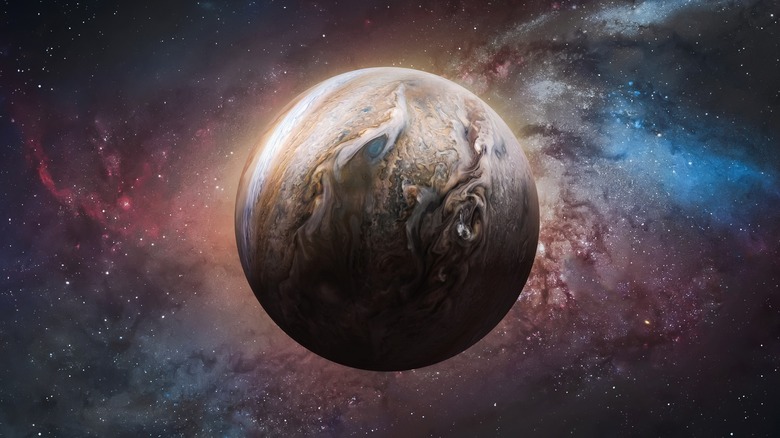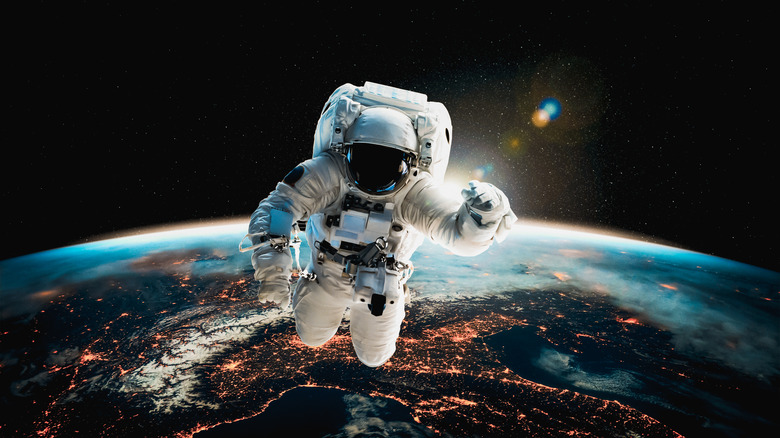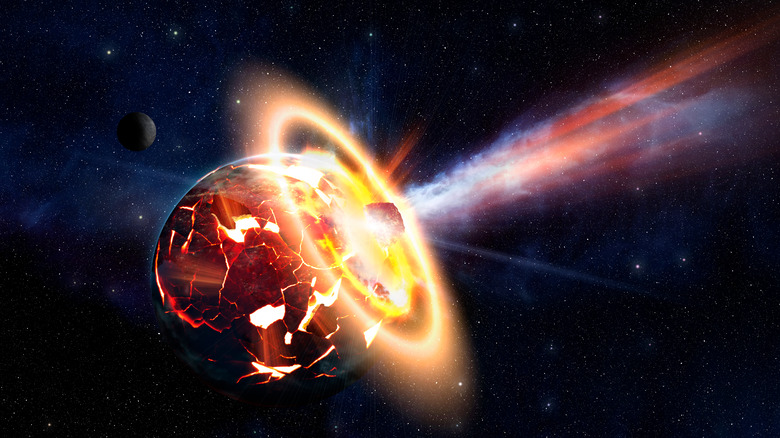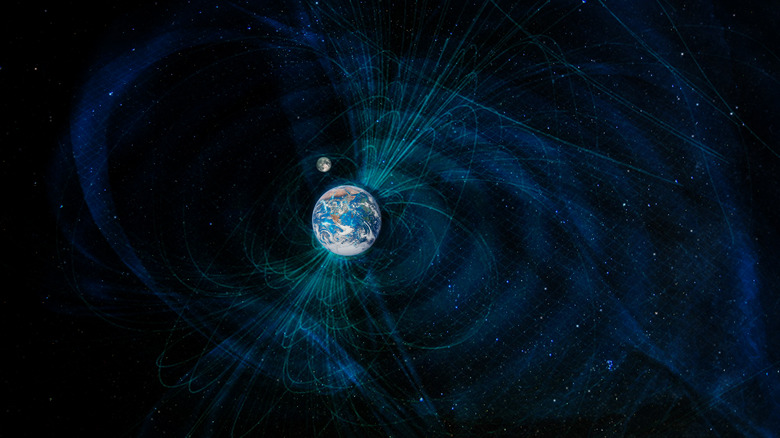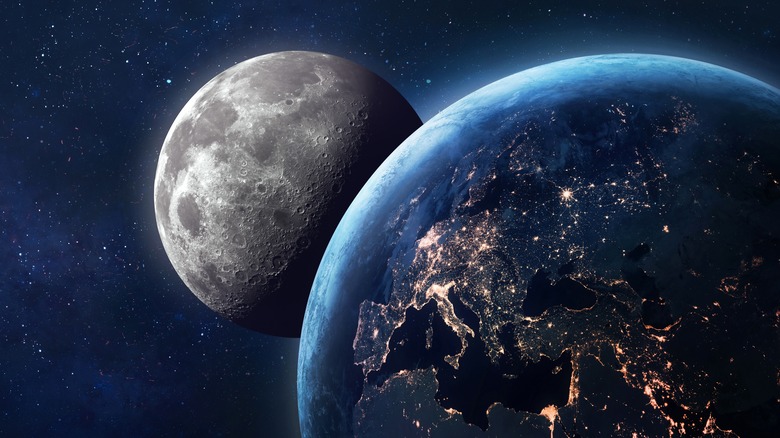What Would Happen If Earth Was The Size Of Jupiter?
Both Earth and Jupiter rotate around the same star, our sun. But that's about where the similarities end. Earth is a rocky planet with a radius of just under 4,000 miles (via Space.com). It houses all sorts of lifeforms thanks to its liquid water, atmosphere, magnetic field, and distance from the sun. Meanwhile, Jupiter is a massive, gaseous planet much further from the sun without the ability to house lifeforms the way Earth does. According to NASA, it is 11 times larger than our home planet, making it the most massive in our solar system.
What would happen if Jupiter and Earth did share more in common? What if Earth were suddenly 11 times larger, matching Jupiter's unfathomable size? Unfortunately, the outcome would not necessarily be more space and resources for our growing population. In fact, the results might make a once thriving Earth no longer habitable thanks to sudden and significant changes in its gravity.
Earth's gravity would greatly increase
Perhaps the most notable change that would take place if Earth were to become the size of Jupiter would be its new, much stronger gravity. Since Jupiter is 11 times larger than Earth, Earth's gravity would increase 11 times. According to The What If Show, the pull of the gravitational field would be so intense that your muscles wouldn't be strong enough to move your body.
But what if, instead of increasing instantly in size, Earth was just as large as Jupiter from the beginning? The most significant difference would be in the size of things. According to Live Science, everything would be shorter, including mountains, trees, animals, and people. This is because the more gravity there is, the more you have to resist it. Smaller objects weigh less and thus do not have to resist gravity as much. In fact, we have already observed the effects of gravity on height by studying astronauts who have spent extended periods of time in zero gravity. Without the influence of Earth's gravity pulling on their spines, astronauts can actually grow taller if they spend enough time in space (via the National Space Centre).
Air pressure increases would make breathing difficult
If a sudden increase in Earth's gravity wasn't enough to make breathing impossible for you, the increase in air pressure would. According to The What If Show, if Earth's gravity were to instantly match that of Jupiter's, air would also be affected. Specifically, the air molecules surrounding us would be pulled down more, increasing Earth's atmospheric pressure.
While an increase in atmospheric pressure would certainly be difficult on our lungs, that wouldn't be the only impact it would have. Atmospheric pressure plays an important role in how water molecules behave. According to the Pew Research Center, water boils at lower temperatures in higher altitudes thanks to a decrease in atmospheric pressure at those heights. If the atmospheric pressure were to increase, you would have to heat water even more to get it to boil. This could have a significant impact on the weather cycle, as it would be harder for water molecules to escape their liquid form and evaporate (via National Geographic).
Asteroids would be more likely to hit us
In addition to changing things on the surface of the planet, Earth's new increase in gravity would also affect how it attracts objects in space. If Earth were the size of Jupiter, it would be able to pull in more asteroids, including larger ones (via Live Science). According to The Planetary Society, asteroids big enough to cause significant global changes only hit Earth once every hundred million years or so.
Earth is mostly shielded from asteroids thanks to its small size. Meanwhile, Jupiter tends to take on a much larger number of asteroids per year. In fact, some astronomers actually believe we are partially protected from comets and asteroids smashing into Earth's surface thanks to Jupiter's intense gravity (via EarthSky). Jupiter does this by pulling in space debris and either rerouting it or destroying it, preventing us from running into it later. If Earth were the size of Jupiter, we might expect to see more asteroids crashing into the surface that would have otherwise flown by if it weren't for the increased gravity.
Earth's magnetic field might disappear
One effect of a larger Earth that might not be immediately noticeable would take place under the surface. Earth currently has a molten iron core, which is responsible for creating a magnetic field around the planet (via National Geographic). If the amount of pressure on the Earth's core were to increase, this could result in the core solidifying. According to Science Focus, it would take billions of years before the Earth's core could completely solidify. But on an Earth with increased gravity, this might change.
The magnetic field generated by the Earth's core is important for the survival of the planet. According to Cosmos Magazine, without our magnetic field, we would be exposed to harmful amounts of radiation from the sun. Speaking to Live Science, Rory Barnes of the University of Washington, who studies planet habitability, said that our magnetitic field "shields life on the planet from the nastiness of space." Without our magnetic field, harmful radiation could cause a slew of issues on Earth for planets, animals, and people.
The Moon would be ripped apart
Out of all the changes that would take place if Earth were the size of Jupiter, the most dramatic would be how it would affect our moon. Our moon is an average of 238,855 miles away from us (via NASA Space Place). With our current gravity and this distance, the moon is able to revolve around the Earth about once every 28 days (via Forbes).
If Earth had more gravity, the moon would experience extreme changes in tidal forces, according to The What If Show. This is because the moon would be pulled too close to Earth's Roche limit, a distance in astronomy used to describe the point at which larger satellites are pulled apart by their planet's gravity (via Britannica). We see evidence of what it looks like to get too close to a planet's Roche limit when we look at Saturn, a planet that has rings that may have once been moons that got too close (via NASA).
